Algorithm state: what happens to indie developers on Steam?
- Transfer
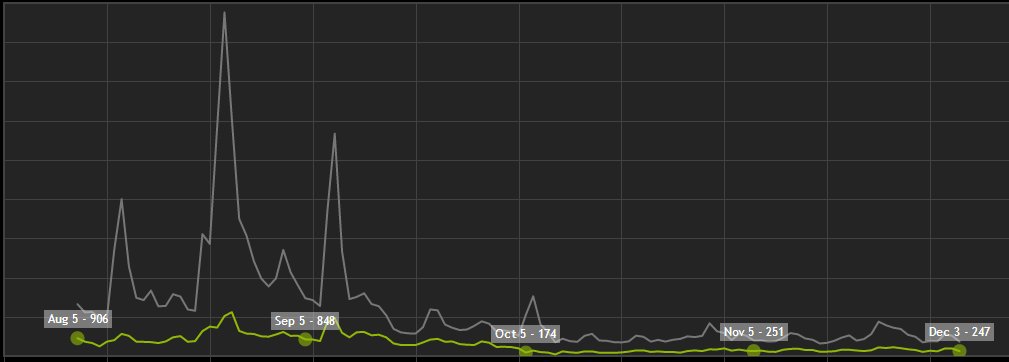
The business of creating indie games has always been difficult, but recently it has become even more difficult. October 5 last year, Valve announced a change in the algorithms of Steam, which led to a decrease in traffic from games that did not become bestsellers. This already hurts indie developers, but I think we are just beginning to feel the impact of these changes.
Perhaps you know about the October Bug of October Steam, and you may have heard. that this bug was fixed. But the situation is somewhat more complicated. Unfortunately, no one outside of Valve knows exactly what is going on; data is simply not available. But I, as I could, tried to analyze the situation. As far as I understand, events developed in the following order:
- On October 5, the “More Like This” section, displayed on the page of each game, began to recommend only a small number of best-selling games, usually weakly resembling the game from the page.
- Accordingly, many developers have noticed a sharp decline in traffic to their pages in the store. The discussion on the Steam developer forums has begun. There are already 60 pages of comments in this thread. According to my observations, for many games this loss of traffic was associated with a decrease in the presence in the “List of Recommendations” and in the “Primary Cluster (Personal Recommendations)”, and this was not due to changes in “Similar Products”.
- On October 9, the “Similar Products” section again began to show previous recommendations, but in general, traffic to the store’s pages did not recover.
- In early December, while arguing that Valve was offering a better revenue share to best-selling games, Jake Birkett began a discussion about reducing traffic on Twitter and on his blog. The culmination of these discussions were articles in PC Gamer and Kotaku .
- On December 4, Valve released a statement explaining:
- On October 5, the company deployed the code in Steam, which "... changed the standard parameters of the search queries, so that they were more affected by sales and activity in wish lists (wishlists)".
- “This change entailed an unintentional side effect in the form of lowering the priority of tags in the section" Similar products "on the game page in the store."
- “In order to eliminate the error, on October 9 we changed the algorithm of the section“ Similar goods ”to increase the priority of similarity of tags. However, we still retained some of the changes that took into account sales and popularity in the wish lists. On October 30, we again increased the weight of the similarity of labels in accordance with the results we observed. ”
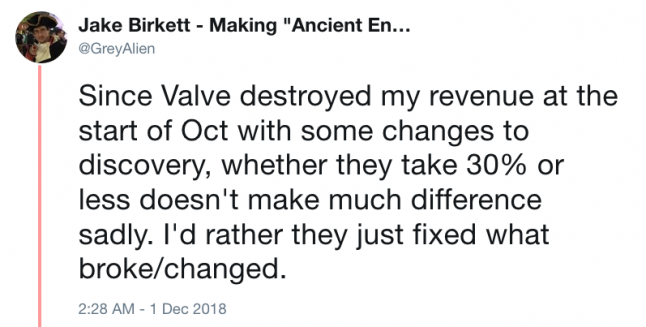
“Since making changes to the recommendations of Steam destroyed my income in early October, now, alas, it doesn’t matter if he takes 30% or less. It remains to hope that they will fix the broken / changed. ”
Valve wants to show people the games they like. The company notes in its news updates that sometimes when working on algorithms, some games get less traffic and some games more. But it seems to me that the most important thing is that what happened with the “Discovery Queue” traffic is a much larger change. It seems that games that are not among the most popular, no longer appear in a certain class of visibility. The question is not that some games win, and some lose. Now, less traffic is sent to a huge number of games that do not correspond to some unknown threshold for daily income.
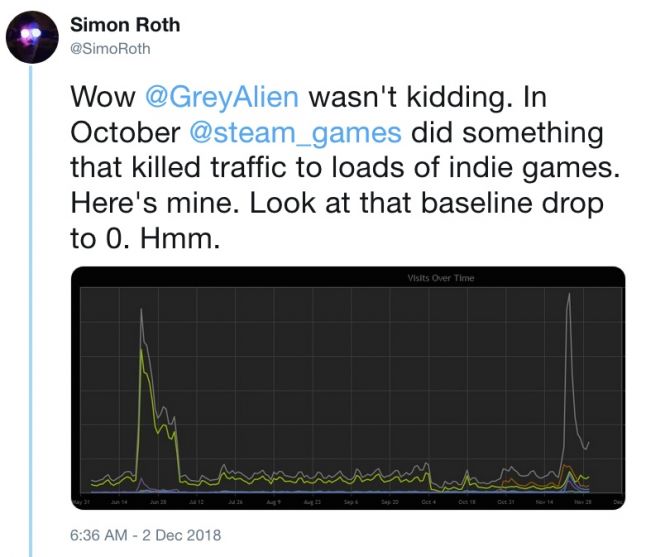
“Wow, GreyAlien really wasn't joking, in October steam_games did something that killed traffic to a bunch of indie games. See this baseline drop to 0. ”
The October changes seem to affect the Discovery Queue and the main cluster. When creating recommendations, the algorithm now takes more into account the income from the game. As a result, the similarity of tags has less effect on what games Steam will recommend to you.

“Wow, I just checked ... the changes are huge: - /”
Valve told us what happened to the “Similar products” widget, but kept silent about the topic of traffic in the “Discovery Queue” and the main page. It is not clear what is the connection between the “Similar products” bug and the changes in these systems. We only know that they occurred simultaneously. Perhaps the traffic changes were another side effect of the same bug, but Valve simply did not notice. Or perhaps the company intentionally changed the recommendation systems so that they more often showed best-selling games. Be that as it may, it seems that this is now a new standard store.

“In order not to stand aside, I also built a schedule. Transitions from “Related Products” have decreased by 70% since September 5. It seems that the decline began on October 5. Correlation does not mean causality, but compared with September, in October, revenues fell by 50%, and November will be even worse.
Why is it so important
In September 2014, Valve rolled out Steam update lists of recommendations (Discovery). In order to adapt the store to the rapidly growing number of added games, the company has made serious efforts to personalize the store page, trying to show users the games that may be of interest to them. These changes, along with the Discovery 2.0 update, which appeared in November 2016, allowed users to show interesting games that they would not otherwise see. Compared to digital stores of mobile platforms and consoles, Steam shows a more diverse and interesting set of games. In fact, I believe that Valve's efforts to improve the recommendations have become the main force weakening the impact of the “indipocalypse” that everyone has been afraid of over the past five years.

"The only hope for decent sales on Steam of many indies is that the" List of Recommendations "will return the previous look OR change it so that it shows among the" popular games "and small indie games with good reviews."
Therefore, the shift of the algorithm towards more popular games and bestsellers is a serious question. For niche games, traffic from the “List of Recommendations” is one of the most important sources of traffic on Steam. One of the reasons why it is so important is that people who study their list of recommendations are literally looking for new games. If someone on Steam wants to find unfamiliar games, these are the “List of Recommendations” users.
Another factor is that the “List of Recommendations” responds to increased sales by generating additional traffic.Lars Dusett has documented the effects of positive feedback created by Steam systems after TotalBiscuit yutuber released a review of his game Defender's Quest. These systems have the effect of enhancing the marketing that the developer is able to provide, making these measures much more successful than if the author did it alone.
Finally, one of the most important features of the “List of Recommendations” is that in the last few major sales Valve has offered users as a reward for exploring its list of cards. Most of the games during sales Valve never recommends, so the increased traffic from the "List of recommendations" was a vital source of visibility of the game.
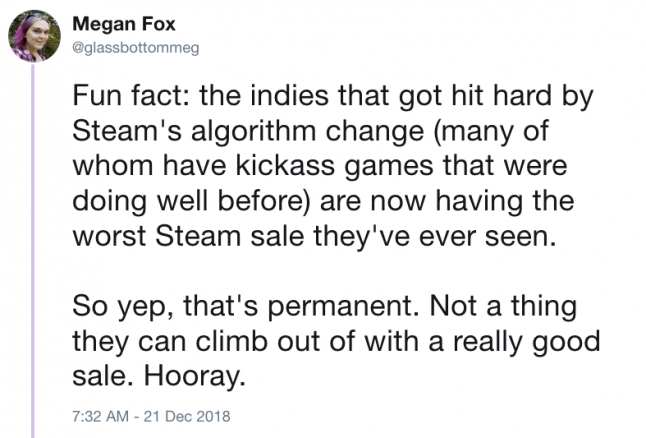
“A funny fact: the indie, which was hit hard by the changes in the Steam algorithm (and many of them sold terrific games, which were previously good), now get the worst sales ever. And yes, the situation will not change. From this pit they can not get through even good sales. Hooray".
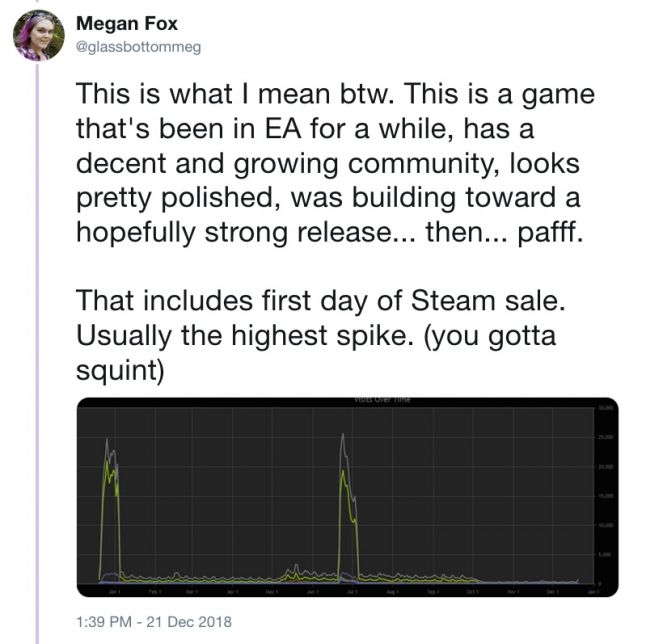
“That's what I mean. This is a game that has been in early access for some time, it has a decent and expanding community. The game looks good enough and gradually it had to come to a loud release. But then ... zilch. The graph shows the first day of sales in Steam, usually the highest peak (to see it, you have to squint). "
This is not the first change in recommendation systems that has led to a change in traffic. Valve has been setting up these systems since their inception. But the October change is notable for how significant and large-scale its influence has become. A large-scale reduction in traffic is bad for indie games and, in my opinion, bad for the industry. I hope that Valve pays attention to what is happening and decides to reverse the changes.

“I hear from many developers that they received half or a third of what they usually received on holidays from the Steam winter sale. Valve generated indipocalypse. ”
Valve does not own any traffic. But she is going to convey these views to users, and I really want her to be careful and not to bury niche and indie games. Although popularity is important data, it does not guarantee the interest of the game for the player or its quality. And in the "List of recommendations", where players are still looking for games unknown to them, popularity is a particularly unfortunate metric for matching.
Bizarre is great. Variety is great. Striving for niche is great. But these types of games naturally do not become bestsellers. If sales are now a requirement for recommendation systems on Steam, then we will no longer see games of this type. They will be less. Developers will have less freedom to experiment. And it will be a huge loss.

"Steam tracks my preferences with sniper accuracy." Games are recommended because the user has played games with the tags Singleplayer and Multiplayer.
In addition to the fact that these changes are bad for small games, they seem to make the “List of Recommendations” less effective in providing recommendations for each user. Considering a narrower set of games, the “List of Recommendations” makes less relevant recommendations. Over the past month I have reviewed over 400 recommendations from my personal “List of Recommendations”. And it seems that basically I get poorly targeted recommendations from popular games with a small number of matching tags. (In the next article I will present a deeper analysis of this data array.)
What's next?

"This is amazing. Indie game developer who wished to remain anonymous. She has been in the store for many years ... and for the first time in this time the number of lists of the desired is reduced. This never happens on Steam sales. Traffic drives more add-ons to your wish lists than sales. It does NOT receive traffic. Only those who once put it on the wishlist buy the game. ”
Lars Dussett survey from early Decembershows that the biggest problem for indie developers is “how to prevent me from ignoring the algorithm”. What we see in October is precisely the source of such alarms. Developers are at the mercy of Valve and are now forced to adapt to this new status quo. If you have a game released or soon released on Steam, then look at your traffic and revenue figures from October. Compare last winter sale with the previous one. You may need to revise your revenue forecasts or increase your marketing budget, because you probably get a smaller presence than you are used to.

“I assume that if the October changes are not rolled back, then from May-July of this year we will start to see the indie crisis, because a decline in sales on Steam will put too much pressure on many indie studios.”
Valve announced that it is working on a new system of recommendations based on machine learning, so we know that changes are coming again. In the meantime, if Valve had simply returned to the recommendation systems as they were in September, this alone would have been a victory. In addition, I would love to see improved Steam recommendation algorithms. I want the "List of Recommendations" to correctly display high-quality games that match the user's tastes. I do not think that we will ever completely get rid of popularity as a metric for the visibility of games, but I hope that Valve will make its influence not suppress other factors, especially in such functions as the “List of Recommendations”.
